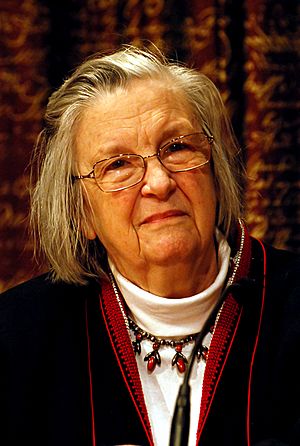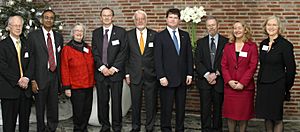Elinor Ostrom facts for kids
Quick facts for kids
Elinor Ostrom
|
|
|---|---|

Ostrom in 2009
|
|
| Born |
Elinor Claire Awan
August 7, 1933 Los Angeles, California, U.S.
|
| Died | June 12, 2012 (aged 78) Bloomington, Indiana, U.S.
|
| Nationality | American |
| Citizenship | United States |
| Spouse(s) | Charles Scott Vincent Ostrom (1963–2012; her death)
|
| Institution | |
| Field |
|
| School or tradition |
New institutional economics |
| Alma mater | UCLA (BA, PhD) |
| Doctoral advisor |
Dwaine Marvick |
| Contributions |
|
| Awards |
|
| Information at IDEAS / RePEc | |
Elinor Claire "Lin" Ostrom (born Awan; August 7, 1933 – June 12, 2012) was an American political scientist and economist. She is famous for her work on how people manage shared resources. In 2009, she won the Nobel Prize in Economics for her studies on "economic governance," especially how communities handle shared resources like forests or fisheries. She shared the prize with Oliver E. Williamson. Elinor Ostrom was the first woman ever to win the Nobel Prize in Economics.
After earning her degrees in political science from UCLA, Ostrom taught at Indiana University. Later in her career, she also worked with Arizona State University. She was a respected professor and helped lead important research centers. She also advised a journal called Transnational Corporations Review with her husband, Vincent Ostrom.
Since the 1960s, Ostrom was involved in how resources are managed. She created a research center that brought together scientists from many different fields. Her center worked like a "workshop" where everyone collaborated, rather than a traditional university with strict lectures.
Ostrom spent many years studying how people interact with nature. She showed that groups of people, like communities or co-ops, can manage shared resources wisely. They can prevent these resources from running out without needing the government or private companies to step in.
Contents
Early Life and Education
Elinor Claire Awan was born in Los Angeles, California. She was the only child of Leah Hopkins, a musician, and Adrian Awan, a set designer. Her parents separated when she was young, and she mostly lived with her mother. She went to a Protestant church with her mother and spent weekends with her father's Jewish family. Elinor described herself as a "poor kid" growing up after the Great Depression. She loved swimming and even taught it to earn money for college.
Ostrom went to Beverly Hills High School, graduating in 1951. She was lucky because many students from her school went to college. In high school, she joined the debate team. This was very important for her thinking. It taught her that public policy issues have two sides, and it's important to understand both. Even though she was discouraged from taking advanced math, she decided to go to college. No one in her family had gone to college before.
She attended UCLA and earned a degree in political science in 1954. She finished in three years by taking extra classes. She worked at the library and stores to pay her tuition, which was $50 per semester. After college, she found it hard to get a job because employers thought she only wanted to be a teacher or secretary. She eventually got a job as an export clerk. This job made her think about going to graduate school.
Because she hadn't taken much math, she was not accepted into UCLA's economics Ph.D. program. But she was accepted into the political science graduate program. She earned her master's degree in 1962 and her Ph.D. in 1965. For her Ph.D., she studied how different groups managed groundwater in Southern California. She saw how people from different areas, who all used the same water, worked together to solve problems. They found ways to stop saltwater from ruining the water supply. This study became the topic of her Ph.D. paper. It laid the groundwork for her famous work on "shared resources."
In 1963, she married Vincent Ostrom, who was her political science professor. Their partnership was a lifelong journey of "love and contestation," as Elinor described it. In 1965, they moved to Bloomington, Indiana, where Vincent became a professor at Indiana University. Elinor joined the faculty as a visiting assistant professor.
Career Highlights
Ostrom's research was based on real-world studies. During her Ph.D., she spent years studying "water wars" in California. She saw how people were not helpless when resources started to run out. Instead, they often found ways to manage them. In her book Governing the Commons, she looked at irrigation systems in Spain and Nepal, mountain villages in Switzerland and Japan, and fisheries in Maine and Indonesia.
Ostrom is best known for challenging the idea of the "tragedy of the commons." This idea, proposed by biologist Garrett Hardin, suggested that shared resources would always be overused and destroyed. Hardin believed that people would act selfishly and deplete common resources.
Elinor Ostrom's book, Governing the Commons, showed a different story. She proved that communities can create rules and ways to manage shared resources. These rules allow people to use the resource without destroying it. This means that resources can be used wisely and renewed, even with selfish behavior, as long as there are agreed-upon rules and controls.
In 1973, Ostrom and her husband started the Workshop in Political Theory and Policy Analysis at Indiana University. This workshop studied how people use teamwork and trust to manage shared resources. Her approach to public policy is called the Institutional analysis and development framework (IAD). It's seen as a unique way of thinking about how public decisions are made. Ostrom wrote many books on how organizations work, political science, and public administration. She was a dedicated scholar until the very end of her life.
For a long time, many experts thought that shared natural resources would always be overused and ruined. Elinor Ostrom proved this wrong. She did studies in small, local communities. She looked at how they managed shared pastures, fishing areas, and forests. She showed that when people who use a resource work together, they create rules. These rules help them care for and use the resource in a way that is good for both the economy and the environment.
Elinor Ostrom became a full professor of Political Science in 1974. She led the department from 1980 to 1984. The Workshop she co-founded brought together scholars from different fields. They wanted to understand how different rules and social settings affected how people behaved and what happened with resources. Their goal was to build a network of scholars around the world who cared about forests and other resources.
Ostrom's important research was supported by many organizations. She worked internationally, with experience in Kenya, Nepal, and Nigeria. She also visited Australia, Bolivia, India, Indonesia, Mexico, the Philippines, Poland, and Zimbabwe for research. She and her husband helped many international students and researchers. They didn't have children of their own, so they used their own money and efforts to get grants to help others.
Ostrom was a founding member and the first president of the International Association for the Study of the Commons (IASC).
Research Focus
Ostrom's early work looked at how public choices affect shared goods and services. For example, she studied how police services were organized in Indianapolis. She believed that managing shared resources needed to be a team effort, organized by the people on the ground. It had to be based on trust and discussed face-to-face. Ostrom also used game theory to predict how people would act when resources were limited. In her workshop, students were given shares in a common resource. When they talked about what to do before acting, their "investments" did much better.
Her later, more famous work focused on how people interact with ecosystems to keep resources healthy for a long time. Shared resources include many forests, fisheries, oil fields, grazing lands, and irrigation systems. She studied how local people managed pastures in Africa and irrigation systems in villages in western Nepal. Her work showed how societies have created different ways to manage natural resources. In many cases, these ways have prevented resources from running out. She stressed that there's no single "magic solution" for all environmental problems.
Ostrom found eight "design principles" that help local communities successfully manage shared resources:
- Clear Boundaries: Everyone knows who belongs to the group using the resource, and outsiders are kept out.
- Local Rules: The rules for using the resource fit the local conditions.
- Fair Decisions: Most people who use the resource can help make decisions about it.
- Good Monitoring: People from the community, or those they trust, check to make sure rules are followed.
- Graduated Sanctions: There are clear, increasing punishments for breaking the rules.
- Easy Conflict Resolution: There are simple and affordable ways to solve disagreements.
- Recognized Self-Governance: Higher authorities respect the community's right to manage its own resources.
- Nested Layers (for large resources): For very large resources, management is organized in smaller, connected groups.
These principles have been updated to include other important factors. These include good communication, trust among users, and the nature of the resource itself.
Ostrom and her team also developed a detailed "Social-Ecological Systems (SES) framework." This framework helps understand how people and nature interact and how communities can govern themselves.
Protecting the Environment
Ostrom warned against having one big government in charge of solving global environmental problems. She believed these problems are too complex and involve too many different people. Instead, she suggested a "polycentric" approach. This means that important decisions should be made by the people closest to the problem.
Ostrom helped prove wrong the idea that natural resources would always be overused. She showed that when local communities manage shared resources like pastures, fishing areas, and forests, they can create rules. These rules help them use the resources in a way that is good for both the economy and the environment.
Ostrom's Law
Ostrom's law is a saying that describes how Elinor Ostrom's work changed ideas about shared resources. Before her, many thought that shared resources would always fail. But Ostrom's detailed studies of real-life examples showed that communities can manage resources successfully. Her work created a new way of thinking about how resources can be organized and used.
Awards and Recognition
Ostrom was a member of important groups like the National Academy of Sciences and the American Philosophical Society. She also served as president of the American Political Science Association. In 1999, she was the first woman to receive the Johan Skytte Prize in Political Science, a very respected award.
She received many other awards throughout her career. In 2008, she was the first woman to win the William H. Riker Prize in political science. The next year, she received the Tisch Civic Engagement Research Prize. In 2010, Utne Reader magazine named her one of the "25 Visionaries Who Are Changing Your World." In 2012, Time magazine included her in its list of "100 Most Influential People in the World."
In 2019, Indiana University Bloomington announced that a statue of Ostrom would be placed outside the political science department building. This was part of an effort to recognize important women.
Nobel Prize in Economics
In 2009, Ostrom made history by becoming the first woman to receive the Nobel Prize in Economics. The Royal Swedish Academy of Sciences honored her "for her analysis of economic governance." They said her work showed how groups could successfully manage shared property. Ostrom and Oliver E. Williamson shared the prize money. As she had done with other awards, Ostrom donated her Nobel prize money to the Workshop she helped create.
The Royal Swedish Academy of Sciences explained that Ostrom's research brought the topic of shared resources to the forefront. She showed how common resources—like forests, fisheries, oil fields, or grazing land—can be managed well by the people who use them. This was different from the usual idea that governments or private companies were always needed. Ostrom's work challenged traditional thinking. She showed that shared resources can be managed successfully without government rules or private ownership.
The Academy noted that her work "teaches us novel lessons about the deep mechanisms that sustain cooperation in human societies." Some people thought her choice for the Nobel Prize was unusual. But others saw it as a good response to problems in the free market, especially after the 2008 financial crisis.
Later Life and Death
Elinor Ostrom was diagnosed with pancreatic cancer in October 2011. Even during her last year, she continued to write and give lectures. She passed away on June 12, 2012, at the age of 78. On the day she died, she published her last article, "Green from the Grassroots." The president of Indiana University, Michael McRobbie, said that the university had "lost an irreplaceable and magnificent treasure." Her colleague Michael McGinnis noted that Ostrom donated her share of the Nobel prize money to the Workshop. Her husband, Vincent, died 17 days later from cancer-related issues. He was 92.
Selected publications
Books
- Ostrom, Elinor (1990). Governing the Commons: The Evolution of Institutions for Collective Action. Cambridge, UK: Cambridge University Press. ISBN 978-0-521-40599-7.
- Ostrom, Elinor; Schroeder, Larry; Wynne, Susan (1993). Institutional incentives and sustainable development: infrastructure policies in perspective. Boulder: Westview Press. ISBN 978-0-8133-1619-2.
- Ostrom, Elinor; Walker, James; Gardner, Roy (1994). Rules, games, and common-pool resources. Ann Arbor: University of Michigan Press. ISBN 978-0-472-06546-2.
- Ostrom, Elinor; Walker, James (2003). Trust and reciprocity: interdisciplinary lessons from experimental research. New York: Russell Sage Foundation. ISBN 978-0-87154-647-0.
- Gibson, Clark C.; Andersson, Krister; Ostrom, Elinor; Shivakumar, Sujai (2005). The Samaritan's Dilemma: The Political Economy of Development Aid. Oxford Scholarship Online. ISBN 978-0-199-27885-5.
- Ostrom, Elinor (2005). Understanding institutional diversity. Princeton: Princeton University Press. ISBN 978-0-691-12238-0.
- Ostrom, Elinor; Kanbur, Ravi; Guha-Khasnobis, Basudeb (2007). Linking the formal and informal economy: concepts and policies. Oxford: Oxford University Press. ISBN 978-0-19-923729-6.
- Ostrom, Elinor; Hess, Charlotte (2007). Understanding knowledge as a commons: from theory to practice. Cambridge, Massachusetts: MIT Press. ISBN 978-0-262-51603-7.
- Ostrom, Elinor; Poteete, Amy R; Janssen, Marco A (2010). Working Together: Collective Action, the Commons, and Multiple Methods in Practice. Princeton: Princeton University Press. ISBN 978-0-691-14604-1.
- Ostrom, Elinor; Lam, Wai Fung; Pradhan, Prachanda; Shivakoti, Ganesh (2011). Improving Irrigation in Asia Sustainable Performance of an Innovative Intervention in Nepal. Cheltenham, UK: Edward Elgar. ISBN 978-0-857-93826-8.
- Cole, Daniel H.; Ostrom, Elinor (2011). Property in Land and Other Resources. Cambridge, MA: Lincoln Institute of Land Policy. ISBN 978-1-55844-228-3.
- Ostrom, Elinor; Chang, Christina; Pennington, Mark; Tarko, Vlad (2012). The Future of the Commons Beyond Market Failure and Government Regulation. London: The Institute of Economic Affairs. ISBN 978-0-255-36653-3.
Journal articles
- Ostrom, Elinor; Crawford, Sue E. S. (September 1995). "A grammar of institutions". American Political Science Review 89 (3): 582–600. doi:10.2307/2082975.
- Ostrom, Elinor (March 1998). "A behavioral approach to the rational choice theory of collective action: Presidential address, American Political Science Association, 1997". American Political Science Review 92 (1): 1–22. doi:10.2307/2585925. http://vgmu.hse.ru/data/2010/12/31/1208184461/%D0%9E%D1%81%D1%82%D1%80%D0%BE%D0%BC%205-52.pdf.
- Ostrom, Elinor (24 July 2009). "A General Framework for Analyzing Sustainability of Social-Ecological Systems". Science 325 (5939): 419–422. doi:10.1126/science.1172133. PMID 19628857.
- Ostrom, Elinor (June 2010). "Beyond markets and states: polycentric governance of complex economic systems". American Economic Review 100 (3): 641–672. doi:10.1257/aer.100.3.614. Pdf version.
See also
 In Spanish: Elinor Ostrom para niños
In Spanish: Elinor Ostrom para niños
- Co-production of public services by service users and communities.
- Institutional analysis and development framework (IAD)



